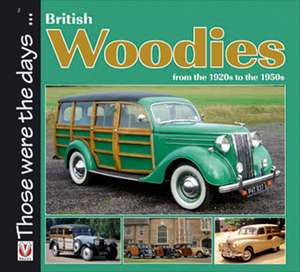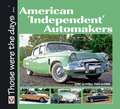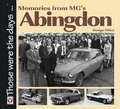British Woodies: Those Were the Days...
Autor Colin Pecken Limba Engleză Paperback – 25 iun 2008
In the 1920s, 30s and 40s, wooden-bodied shooting brakes, estate cars and station wagons were commercial vehicles built in Britain mostly for utilitarian roles. They were built in relative small numbers, often by small lesser-known commercial bodybuilding firms and required high levels of maintenance to ensure anything resembling a long life. Every chassis from Alvis, Austin and Bentley to Standard, Vauxhall and Wolseley, were built as Woodies at some stage and reached their peak of popularity in the immediate post-war years when steel was in short supply and the majority of new cars were being built for export. Some vehicle manufacturers sold wooden-bodied utilities under their own name, but most were built in small workshops under contract to vehicle dealerships or selling direct to the general public. However, labor intensive constriction, high maintenance requirements and the introduction of the unitary chassis by Britain’s car makers all contributed to the eventual demise of the British Woodie. Today, there’s resurgence in the interest in British Woodies across the world with an increasing number of cars being restored and cherished. The work of hundreds of small coachbuilder firms is highlighted and illustrated with 100 rare and previously unpublished photos. The British Woodie is undoubtedly a thing of beauty and this book is a tribute to the skills of the coachbuilder who built these amazing wooden wonders.
Preț: 88.79 lei
Nou
Puncte Express: 133
Preț estimativ în valută:
16.99€ • 17.67$ • 14.03£
16.99€ • 17.67$ • 14.03£
Carte disponibilă
Livrare economică 25 martie-08 aprilie
Livrare express 08-14 martie pentru 22.13 lei
Preluare comenzi: 021 569.72.76
Specificații
ISBN-13: 9781845841690
ISBN-10: 1845841697
Pagini: 96
Ilustrații: Illustrations (some col.)
Dimensiuni: 208 x 185 x 10 mm
Greutate: 0.3 kg
Editura: Veloce Publishing
Seria Those Were the Days...
ISBN-10: 1845841697
Pagini: 96
Ilustrații: Illustrations (some col.)
Dimensiuni: 208 x 185 x 10 mm
Greutate: 0.3 kg
Editura: Veloce Publishing
Seria Those Were the Days...
Recenzii
Classics Monthly, September 2008
UK magazine
As club chairman of the Woodie Car Club, Colin Peck is the ideal author for this fascinating glimpse into British part-wood estate cars. The early half of the 20th century was the golden age, and Woodies weird and wonderful are crammed into this book, from humble Austins and Fords to a Jaguar XK140 and Rolls-Royces. The Second World War saw many exotic saloons turned into wooden-bodied ambulances - there's something very appealing about a sporting Bentley Woodie. There are also a handful of rare assembly line photos giving a fascinating insight into the handbuilt production of these cars. By the late 1950s, with the exception of the Morris Minor Traveller, the Woodie had all but died out. The last chapter looks at a few daunting restoration projects that will almost certainly bring tears to your eyes. Yes, it's specialist subject matter, but one that will appeal.
-
Classic & Sports Car, September 2008
UK magazine
Circ: 82,000
Who better to write a book on British-built woodies than the founder of the Woodie Car Club? The latest in Veloce's square paperback 'Those were the days ...' series, this 90-page edition is packed with insight and photos. Pre-war designs are covered briefly, the main focus being 1946-54, the 'golden years of the shooting brake' when woodies were exempt from purchase tax. Peck relates how Austin was first to launch a factory-approved woodie - built by Papworth Industries - soon followed by Lea-Francis. Chapters review wartime woodies, chassis builders and specialist body firms; illustrations are a mix of period shots of long-lost cars and a gallery of survivors including Peck's Austin A70 Hampshire Countryman. Rarest of all is a one-off Invicta Black Prince with a bizarre woodie body by Associated Coachcraft.
UK magazine
As club chairman of the Woodie Car Club, Colin Peck is the ideal author for this fascinating glimpse into British part-wood estate cars. The early half of the 20th century was the golden age, and Woodies weird and wonderful are crammed into this book, from humble Austins and Fords to a Jaguar XK140 and Rolls-Royces. The Second World War saw many exotic saloons turned into wooden-bodied ambulances - there's something very appealing about a sporting Bentley Woodie. There are also a handful of rare assembly line photos giving a fascinating insight into the handbuilt production of these cars. By the late 1950s, with the exception of the Morris Minor Traveller, the Woodie had all but died out. The last chapter looks at a few daunting restoration projects that will almost certainly bring tears to your eyes. Yes, it's specialist subject matter, but one that will appeal.
-
Classic & Sports Car, September 2008
UK magazine
Circ: 82,000
Who better to write a book on British-built woodies than the founder of the Woodie Car Club? The latest in Veloce's square paperback 'Those were the days ...' series, this 90-page edition is packed with insight and photos. Pre-war designs are covered briefly, the main focus being 1946-54, the 'golden years of the shooting brake' when woodies were exempt from purchase tax. Peck relates how Austin was first to launch a factory-approved woodie - built by Papworth Industries - soon followed by Lea-Francis. Chapters review wartime woodies, chassis builders and specialist body firms; illustrations are a mix of period shots of long-lost cars and a gallery of survivors including Peck's Austin A70 Hampshire Countryman. Rarest of all is a one-off Invicta Black Prince with a bizarre woodie body by Associated Coachcraft.
New Zealand Classic Car, October 2008
NZ magazine
In this book, another in Veloce's 'Those Were The Days' series, Colin Peck takes an affectionate look at what he calls British Woodies ߝ although somehow the term remind me more of California than of Lea-Francis. After an overview of their birth as a utility vehicle for country estates, Peck looks at the use of woodies in WWII (when they were sometimes cut down for desert welfare); the attraction of their tax-exempt status; and their slow decline because of the complexities of their manufacture, the need for frequent maintenance, and the rise of the unitary body structures. There are separate chapter on marques that had some woody bodies made on them (Allard, Morris) and body builders, many of which weren't traditionally associated with the motor trade. Peck doesn't claim to have written a definitive history, but it's still an interesting read. You're just as likely to buy the book for the photos anyway. There are about 100 of them, a mix of contemporary photos and shots of restored woodies. You see Austin A70 Countrymen on the assembly line at Papworths, and other cars that are much more of a one-off like the unique Invicta Black Prince. Most of the cars shown are pretty square-sided and traditional, like a Bentley R-type and a Morris Y, but there are some fascinating variations such as the Allard P2 Safari, and a fastback woody body on Riley RM. This book is reasonably priced, and well worth a look.
NZ magazine
In this book, another in Veloce's 'Those Were The Days' series, Colin Peck takes an affectionate look at what he calls British Woodies ߝ although somehow the term remind me more of California than of Lea-Francis. After an overview of their birth as a utility vehicle for country estates, Peck looks at the use of woodies in WWII (when they were sometimes cut down for desert welfare); the attraction of their tax-exempt status; and their slow decline because of the complexities of their manufacture, the need for frequent maintenance, and the rise of the unitary body structures. There are separate chapter on marques that had some woody bodies made on them (Allard, Morris) and body builders, many of which weren't traditionally associated with the motor trade. Peck doesn't claim to have written a definitive history, but it's still an interesting read. You're just as likely to buy the book for the photos anyway. There are about 100 of them, a mix of contemporary photos and shots of restored woodies. You see Austin A70 Countrymen on the assembly line at Papworths, and other cars that are much more of a one-off like the unique Invicta Black Prince. Most of the cars shown are pretty square-sided and traditional, like a Bentley R-type and a Morris Y, but there are some fascinating variations such as the Allard P2 Safari, and a fastback woody body on Riley RM. This book is reasonably priced, and well worth a look.
Classic Motor Monthly, September 2008
UK magazine
Circ: 14,500+
A book that I had eagerly been awaiting was 'British Woodies' (from the 1920s to the 1950s) by Colin Peck. It's from Veloce's 'Those were the days' series. As Colin admits in his introduction the book is not intended to be a definitive history, but more an introduction to the subject. This is a very good introduction to the subject, many illustrations with excellent historic and modern photographs: Highly recommended.
-
Octane, October 2008
UK magazine
A really interesting little softback about a previously unexplored subject, this book contains some great archive shotsߝ especially of WW2 utilities, and of shooting brakes under construction. Spanning the 1920s-1950s, it outlines the surprisingly large number of body builders involved, and is brightened with color photos of surviving cars.
UK magazine
Circ: 14,500+
A book that I had eagerly been awaiting was 'British Woodies' (from the 1920s to the 1950s) by Colin Peck. It's from Veloce's 'Those were the days' series. As Colin admits in his introduction the book is not intended to be a definitive history, but more an introduction to the subject. This is a very good introduction to the subject, many illustrations with excellent historic and modern photographs: Highly recommended.
-
Octane, October 2008
UK magazine
A really interesting little softback about a previously unexplored subject, this book contains some great archive shotsߝ especially of WW2 utilities, and of shooting brakes under construction. Spanning the 1920s-1950s, it outlines the surprisingly large number of body builders involved, and is brightened with color photos of surviving cars.
"... packed with make-by-make histories, historic photos and contemporary photos of restored woodies and those awaiting restoration." ߝ Woodie Times
"Nicely illustrated with period and modern photos, ads, and a few detail shots of workshops. The literature on this subject is exceedingly thin and this book, small as it is, fills a gap." ߝ The Flying Lady
"Nicely illustrated with period and modern photos, ads, and a few detail shots of workshops. The literature on this subject is exceedingly thin and this book, small as it is, fills a gap." ߝ The Flying Lady
"This publication is as delightful as the cars themselves and contains a fascinating collection of period and black-and-white photos as well as color photos of restored examples. Highly recommended." ߝ Australian Classic Car
"This excellent little book recalls the dying gasps of the coachbuilder's art and a number of famous names as well as many more obscure ones ... Recommended." ߝ Gay Classic Car Group
"This excellent little book recalls the dying gasps of the coachbuilder's art and a number of famous names as well as many more obscure ones ... Recommended." ߝ Gay Classic Car Group
Notă biografică
Colin grew up in North London and was interested in all forms of road transport from an early age. He initially worked in transport management before moving into transport journalism and then public relations. He restored his first classic car in the 1980s and became on officer of the Mercedes-Benz Club. After a spending four years working in California, where he owned a number of classic cars, he returned to the UK and re-established his career in public relations. After acquiring an Austin A70 Countryman in Canada he formed the Woodie Car Club in 2000 and today is the Club’s chairman.
Cuprins
Foreword & acknowledgements Introduction Woodies at war The chassis makers The body builders Beginning of the end Restoring for tomorrow Index
Descriere
The book focuses on how and why Woodies were first used in the UK and then takes an in-depth look at the how the concept evolved from being a sporting vehicle into a utility vehicle ߝ in essence the original SUV. The book also looks at why some vehicles were built as Woodies from new, while others were re-bodied as Woodies in later life. It also looks at the companies, both large and small, which built Woodies and the reasons why demand peaked in the immediate post-war years and then faded away.








